골절 치료 Treatments of fractures
1. 사진으로 보는 골절치료
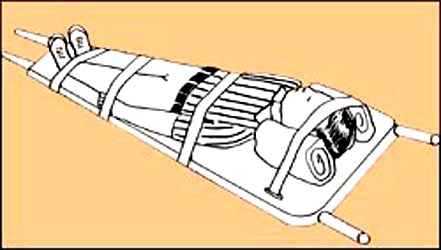
그림 249. 특히 경부 척주의 경추 골절이 의심되면 머리 목을 비롯해 몸통을 함부로 움직여서는 안 된다. 특히 목을 함부로 움직여서는 안 된다.
Copyright ⓒ 2011 John Sangwon Lee, M.D., FAAP
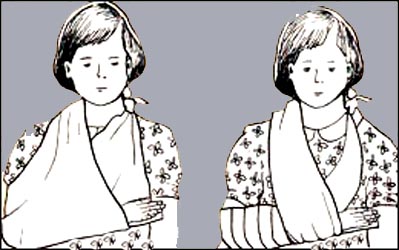
그림 250. 경미한 요골이나 척골이 골절됐다고 의심되면 그림 250과 같이 부목을 대고 병원으로 간다.
Copyright ⓒ 2011 John Sangwon Lee, M.D., FAAP
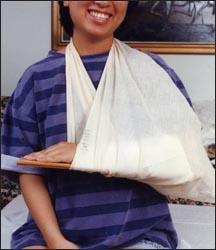
사진 251. 경미한 요골 골절이나 척골 골절을 의심하면 사진 251과 같이 아래 위팔에 부목을 임시로 대고 병원으로 간다.
Copyright ⓒ 2011 John Sangwon Lee, M.D., FAAP

사진 252. 쇄골 골절은 8자 형 스플린트로 치료할 수 있다.
Copyright ⓒ 2011 John Sangwon Lee, M.D., FAAP

사진 253. 손뼈나 손가락 뼈가 경미하게 골절 됐다고 의심되면 사진 253과 같은 부목을 손가락 손 팔목에 대고 병원으로 간다.
Copyright ⓒ 2011 John Sangwon Lee, M.D., FAAP
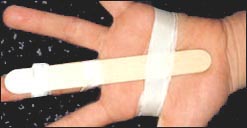
사진 254. 손가락 뼈에 경미한 골절이 생겼다고 의심하면 사진 254와 같이 부목을 손가락, 손 바다, 팔목에 대고 병원으로 간다.
Copyright ⓒ 2011 John Sangwon Lee, M.D., FAAP

사진 255. 아랫 다리 뼈에 경미한 골절이 생겼다고 의심하면 사진 255와 같이 발, 발목, 아래 다리, 위 다리에 부목을 대고 병원으로 간다.
Copyright ⓒ 2011 John Sangwon Lee, M.D., FAAP
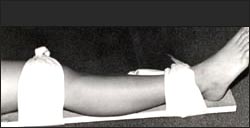
사진 256. 아랫다리 뼈에 경미한 골절이 생겼다고 의심하면 발, 이래 다리, 위 다리에 부목을 대고 병원으로 간다.
Copyright ⓒ 2011 John Sangwon Lee, M.D., FAAP
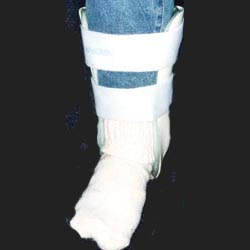
사진 257. 경미한 경골 골절이나 비골 골절은 사진 257과 같이 특수 스플인트로 치료할 수 있다.
Copyright ⓒ 2011 John Sangwon Lee, M.D., FAAP
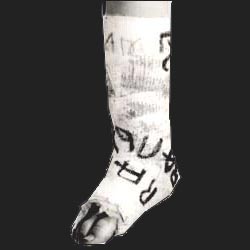
사진 258. 경미한 경골 골절이나 비골 골절은 캐스트 고정 치료(석고붕대 고정치료)를 할 수 있다.
Copyright ⓒ 2011 John Sangwon Lee, M.D., FAAP

사진 259. 골절이 됐거나 골절이 됐다고 의심하면 가능한 한 의사의 지시에 따라 치료한다. 그리고 필요에 따라 구급차를 이용해 병원으로 간다.
Copyright ⓒ 2011 John Sangwon Lee, M.D., FAAP
일반적 골절 치료 포인트
-
병력·증상 징후와 진찰소견을 종합해서 골절이 됐다고 의심되면 의심되는 신체 부위 X선 사진 검사 등으로 진단한다.
- 증상 징후를 제대로 말로 표현할 능력이 없는 어린 영유아들의 팔뼈나 다리뼈에 경미한 골절이 생겼다고 의심될 때는 그쪽 손에서부터 앞 팔 위팔 어깨까지 또는 그쪽 발에서부터 아래 다리 무릎 가랑이까지의 신체 부위를 부모나 처치자가 손으로 살살 눌러 만져보면 골절된 뼈 부위를 찾아 낼 수 있다. 골절된 부위를 집에서도 찾을 수 있다.
- 골절된 국소를 손으로 살살 만지면 어린 영유아는 아파서 소스라치며 울 수 있다.
- 이런 식으로 팔다리뼈가 경미하게 골절됐을 때는 골절된 부위를 집에서 부모가 찾아낼 수 있다. 골절이 경미하게 생겼든 심하게 생겼든 병원에서 확실하게 진단 치료를 받는다.
- 골절이 되었는지 알아보기 위해 골절된 신체 부위를 끌거나 밀거나 구부려서는 안 된다.
- 골절된 뼈의 종류, 골절의 종류와 정도, 합병증의 유무 등에 따라 치료가 다르다.
- 신체 어느 부위에 있는 뼈에 골절이 생겼다고 의심되면 침착하게 환아를 우선 안정시켜야 한다.
- 심하게 골절됐을 때는 가능한 한 골절됐을 때의 상태 그대로 놓아두고 의료구급대, 단골 소아청소년과 의사, 또는 병원 응급실의 긴급 전화 진료 지시에 따라 응급처치를 현장에서 시작한다.
- 골절된 뼈가 있는 팔·다리·손·발 등의 신체 부위의 혈액순환이 잘 안 될 수 있고, 심한 출혈이 있을 수 있고, 쇼크에 빠질 수 있다.
- 말초신경이나 동정맥 혈관 또는 근육 등 연조직이 손상될 수 있다. ([부모도 반의사가 되어야 한다-소아가정간호백과]-제1권 소아청소년 응급의료-염좌, 외출혈 참조.)
- 가능하면 합병증이 있나 알아서 ABCD-
- 기도유지(Airway establishment),
- 호흡유지(Breathing),
- 혈액 순환유지(Circulation),
- 흉부압박(Cardiac compression),
- 약물 투여 진단(여기서는 Drugs and Diagnosis를 의미하지 않음)
등 기본 인명구조 처치를 현장에서 가능하면 의사의 지시에 따라 시작한다.
- 뼈만 조금 골절됐다고 의심 갈 때는 골절된 뼈가 있는 신체 부위와 골절된 신체 부위에 연결된 성한 위아래 신체 부위에 부목을 대고 붕대나 헝겊 등으로 조심스럽게 고정시킨 후 병원응급실로 데리고 갈 수 있다.
- 이런 처치도 가능한 한 긴급 전화 진료를 통한 의사의 지시에 따라 한다.
- 의사의 지시가 없는 한 가능한 한 목격한 골절된 상태 그대로 유지하면서 부목을 댄다.
- 부목이 없으면 얇은 판자나 신문지, 베개 등을 이용해 부목으로 쓸 수 있다.
- 이런 응급처치도 가능한 한 의사의 지시에 따라서 하는 것이 치료 원칙이다.
각종 골절에 관한 응급 처치법
1. 손가락뼈나 손뼈가 경미하게 골절됐다고 의심될 때
- 가능 하면 응급 전화 진료를 의사로부터 받는다. 응급 전화 진료를 통해, 의사의 지시에 따라 골절된 손·손가락·팔목에 부목을 댄다.
- 이 때 손 사진 253처럼 손톱이 보이도록 손가락 끝 부위를 제외하고 손 전체에 부목을 댄다. p.00 염좌, p.00 사진 253, 254, 손뼈와 손가락뼈의 골절 참조.
2. 손목관절(완관절)에 있는 뼈가 골절됐다고 의심되면
- 가능 하면 응급 전화 진료를 의사로부터 받는다. 의사의 지시에 따라 그쪽 손가락에서부터 그쪽 손바닥, 손목을 포함해서 팔꿈치까지 부목을 댄다.
- 이 때 역시 손, 손목의 혈액순환이 잘되나 관찰할 수 있도록 손가락 끝부분이 잘 보이게 부목을 댄다.
- 손가락뼈나 손바닥뼈나 손목뼈(완관절에 있는 뼈)가 골절되어 손이나 손목이 구부러졌을 때도 구부러진 손가락, 손바닥, 또는 손목을 강제로 반듯하게 펴지 말고 구부러진 상태 그대로 부목을 대던지 의사의 지시에 따라 처치한다(사진 251).
3. 아래 팔뼈(하 상박골) 골절이 생겼을 때
- 가능 하면 응급 전화 진료를 의사로부터 받는다. 의사의 지시에 따라 그쪽 손·손목·아래팔·팔꿈치·위팔 전체에 부목을 댄다.
- 아래팔뼈가 심하게 골절되어 팔이 구부러져 있을 때도 구부러진 상태 그대로 부목을 대던지 의사의 지시에 따라 처치한다.
- 특히 팔꿈치관절에 있는 뼈가 골절됐다고 의심됐을 때는 의사의 지시에 따라 부목을 댄다.
- 부목을 댈 때 골절된 손·아래팔·팔꿈치를 당기거나 밀거나 구부려서도 안 된다(상완골 골절 참조).
4. 팔꿈치 관절 뼈가 골절됐다고 의심되면
- 가능 하면 응급 전화 진료를 의사로부터 받는다.
- 의사의 지시에 따라 손·손목·아래팔·팔꿈치·위팔에다 부목을 댄다.
- 앞서 설명한 것같이 주의한다(사진 197, 199 참조).
5. 발뼈나 다리뼈가 골절됐다고 의심될 때도
- 가능 하면 응급 전화 진료를 의사로부터 받는다. 의사의 지시에 따라 1~5 현장 골절 처치 요령으로 부목을 댄다. 사진 230 발목뼈와 사진 239, 240 발뼈 골절 참조.
6. 척추 골절이 생겼다고 의심할 때
- 가능하면 응급 전화 진료를 의사로부터 받는다. 의사의 지시에 따라, 의료구급대나 병원 응급실 지시에 따라 구급차로 병원 응급실로 급히 옮겨야 한다.
- 척추 골절이 있다고 의심되면, 환아를 현장에서 다른 장소로 될 수 있으면 옮기지 말아야 한다.
- 의사의 지시가 없이 환아가 취하고 있는 그 현 상태와 자세를 다른 자세로 함부로 바꾸지 말 고 움직여도 안 된다.
- 부득이한 사정으로 가족들이 환아를 병원으로 데리고 가야 할 경우도 역시 의사의 지시에 따라서 데리고 가야 한다.
- 이 때 머리끝에서 발끝까지 몸 전체를 받쳐 줄 수 있고 충분히 넓고 긴 판자나 딱딱한 들것 위에 환아를 눕히고 병원 응급실로 데리고 간다.
- 환아를 판자나 들것으로 운반할 때 마치 긴 통나무 토막을 움직이는 것같이 환아의 척주나 몸통을 구부리거나 비틀거나 끌거나 밀지 말아야 한다.
- 이런 처치를 할 때 골절된 척추골, 척수나 척수신경 등이 절단될 수 있다.
- 의사의 지시 없이 등을 절대 구부려서도 안 된다(그림 249 참조).
- 병원에 데리고 가는 도중 골절된 척추가 더 이상 움직이지 않도록 무거운 모래주머니나 큰 베개 등으로 머리에서부터 발끝까지의 전신 양쪽에 받쳐 전체 척주(등뼈)를 더 이상 움직이지 않도록 전신을 잘 고정시켜야 할 때도 있다.
- 척추 골절이 생겼는지 알아보기 위해 목이나 가슴, 또는 허리 등을 구부려 보든지 당긴다든지, 또는 밀어서도 절대로 안 된다.
- 부러진 날카로운 척추 뼈 끝이 척추 뼈 속에 들어있는 척수나 척수 신경근 또는 그 부위에 있는 혈관 또는 척수 신경 등을 자를 수 있기 때문이다.
- 척수가 잘리면 대단히 위험할 수 있고, 잘린 척수 이하에 있는 척수에 지배받는 신체에 마비가 생겨 일평생 장애자가 될 수 있다. 척추골 골절 참조
7. 팔다리나 신체 다른 부위 뼈가 골절됐다고 의심되면
- 가능 하면 응급 전화 진료를 의사로부터 받는다. 의사의 지시에 따라 그대로 부목을 대든지(사진 255, 256 참조), 또는 입은 옷을 자르든지, 또는 조심스럽게 옷을 벗긴 후 부목을 댈 수 있다.
- 옷을 벗긴다고 골절된 부위를 조금이라도 밀거나 당기거나 구부려서는 안 된다.
- 자른 옷은 부목을 댈 때 이용할 수 있다.
- 골절된 뼈가 있는 신체 부위에 부목을 대고 붕대나 헝겊 등으로 부목과 골절된 신체 부위를 고정시킬 때 혈액순환을 차단시킬 위험성이 있으므로 너무 꼭 졸라매서는 안 된다.
- 골절된 뼈끝이 골절된 부위에 있는 혈관이나 신경 등을 끊어서 그 부위의 혈액순환이 안 되고 신경마비가 생길 수 있다.
- 부목을 대기 전, 대는 동안, 댄 후, 병원에 데리고 가는 도중 부목을 댄 신체 부위의 혈액순환이 잘되는지 자주 살펴보아야 한다.
- 골절된 부위의 피부색, 손톱이나 발톱 밑의 혈색을 자주 살펴야 한다.
- 손톱 밑이나 발톱 밑의 혈색이 없고, 손발이나 손가락, 발가락 등에 청색증이 생기면 골절로 인해 그 부위에 혈액순환이 잘 안 된다는 것을 의미한다.
- 병원 응급실로 데리고 가는 중 필요에 따라 병원 응급실, 의사의 지시에 따라 적절한 응급처치를 해야 한다.
골절된 뼈의 종류, 골절의 정도, 합병증의 유무에 따라 부목·석고 붕대·수술 등으로 골절을 치료한다.
- [부모도 반의사가 되어야 한다-소아가정간호백과]-제1권 소아청소년 응급의료-골절 참조.
- 사진 257, 258 참조
Treatments of fractures 골절 치료
1. Fracture treatment through photos

Figure 249. In particular, if a cervical vertebra fracture is suspected, the head and neck and the trunk should not be moved indiscriminately. In particular, do not move the neck carelessly. Copyright ⓒ 2011 John Sangwon Lee, M.D., FAAP

Figure 250. If you suspect a minor fracture of the radius or ulna, go to the hospital with a splint as shown in Figure 250. Copyright ⓒ 2011 John Sangwon Lee, M.D., FAAP

Photo 251. If you suspect a minor radius fracture or ulnar fracture, temporarily place a splint on the lower arm as shown in Photo 251 and go to the hospital. Copyright ⓒ 2011 John Sangwon Lee, M.D., FAAP

Picture 252. A clavicle fracture can be treated with a figure 8 splint. Copyright ⓒ 2011 John Sangwon Lee, M.D., FAAP

Picture 253. If you suspect that the bones of the hand or fingers are slightly fractured, place the splint as shown in Picture 253 on the wrist of the finger and hand and go to the hospital. Copyright ⓒ 2011 John Sangwon Lee, M.D., FAAP

Photo 254. If you suspect that you have a minor fracture of your finger bones, place a splint on your finger, hand, or wrist as shown in Photo 254 and go to the hospital. Copyright ⓒ 2011 John Sangwon Lee, M.D., FAAP

Photo 255. If you suspect that you have a minor fracture of the lower leg bone, place a splint on the foot, ankle, lower leg, and upper leg as shown in Photo 255 and go to the hospital. Copyright ⓒ 2011 John Sangwon Lee, M.D., FAAP

Photo 256. If you suspect that you have a minor fracture of the lower leg bone, splint the foot, lower leg, and upper leg and go to the hospital. Copyright ⓒ 2011 John Sangwon Lee, M.D., FAAP

Picture 257. Minor tibia fractures or fibula fractures can be treated with special splints as shown in Picture 257. Copyright ⓒ 2011 John Sangwon Lee, M.D., FAAP

Photo 258. For minor tibia fractures or fibula fractures, cast fixation treatment (plaster fixation treatment) can be performed. Copyright ⓒ 2011 John Sangwon Lee, M.D., FAAP

Photo 259. If you have a fracture or suspect that you have a fracture, treat it according to your doctor’s instructions as much as possible. Then, if necessary, take an ambulance to the hospital. Copyright ⓒ 2011 John Sangwon Lee, M.D., FAAP
Common fracture treatment points
• If a fracture is suspected by combining the medical history/symptoms, signs, and examination findings, it is diagnosed by X-ray examination of the suspected body part.
• When you suspect a minor fracture of an arm or leg bone in young infants or toddlers who are unable to verbalize symptoms, have a parent or caregiver remove the part of the body from the hand to the forearm, upper arm, shoulder, or foot to the lower leg, knee crotch. You can find the fractured bone by pressing it gently with your hand. Fractures can also be found at home.
• If you gently touch the fractured area with your hands, young infants and young children may cry in pain.
• In this way, for minor fractures of the limb bones, parents can find the fractured area at home. Whether the fracture is mild or severe, be sure to diagnose and treat it at the hospital.
• Do not drag, push, or bend a fractured body part to check for a fracture.
• Treatment differs depending on the type of fractured bone, the type and severity of the fracture, and the presence or absence of complications.
• If you suspect that a bone fracture in any part of the body has occurred, calmly and first stabilize the child.
• In case of a severe fracture, leave it as it was when possible, and start first aid on the spot according to the emergency call instructions from the medical emergency department, regular pediatrician, or hospital emergency room.
• Blood circulation to parts of the body with fractured bones, such as arms, legs, hands, and feet, may be impaired, there may be severe bleeding, and you may fall into shock.
• Peripheral nerves, arteriovenous vessels, or soft tissues such as muscles may be damaged. (See [Parents should also become anti-doctors – Encyclopedia of Pediatric and Family Nursing] – Volume 1 Emergency Medical Care for Children and Adolescents – Sprains, blood outside.)
• If possible, check for complications. ABCD-
o Airway establishment;
o Breathing,
o Circulation,
o Cardiac compression,
o Diagnosis of drug administration (not meant here Drugs and Diagnosis) If possible, start basic life-saving measures such as those of the doctor at the scene, as directed by the doctor.
• If you suspect that only a few bones are fractured, you can put a splint on the body part with the fractured bone and the upper and lower body parts connected to the fractured body part, carefully fix it with a bandage or cloth, and then take it to the hospital emergency room.
• If possible, these procedures should also be carried out as directed by your doctor through emergency phone calls.
• Apply a splint while maintaining the observed fracture as far as possible, unless directed by a doctor.
• If you do not have a splint, you can use it as a splint using a thin board, newspaper, or pillow.
• The principle of treatment is to follow the doctor’s instructions as much as possible for such first aid.
First-aid measures for various fractures
1. When it is suspected that a finger or hand bone is slightly fractured
• Get emergency phone care from your doctor whenever possible. Splint your fractured hand, finger, or wrist as directed by your doctor through emergency phone care.
• At this time, apply a splint to the entire hand except for the fingertips so that the nails are visible as in the hand photo 253. Sprains, See pictures 253, 254, fractures of the bones of the hand and fingers.
2. If a bone in the wrist joint (arm joint) is suspected to be fractured
• Get emergency phone care from your doctor whenever possible. As directed by your doctor, splint from your finger to your palm, including your wrist and elbow.
• At this time, the blood circulation of the hands and wrists is also good, but a splint is applied so that the tip of the finger can be seen clearly.
• Even when your hand or wrist is bent due to a fracture of the finger bones, metacarpals, or wrist bones (bones in the arm joint), do not forcefully straighten the bent fingers, palms, or wrists. Apply a splint in the bent state or follow the doctor’s instructions. Treat (Picture 251).
3. When the lower arm bone (lower humerus) fracture occurs
• Get emergency phone care from your doctor whenever possible. Splint your entire hand, wrist, forearm, elbow, and upper arm as directed by your doctor. • Even when the arm is bent due to a severe fracture of the forearm, use a splint in the bent state or treat it according to the doctor’s instructions.
• Apply a splint as directed by your doctor, especially if you suspect a fractured bone in your elbow joint.
• Never pull, push, or bend a fractured hand, forearm, or elbow when splinting it (see Humerus Fracture).
4. If you suspect that the elbow joint bone is fractured
• Get emergency phone care from your doctor whenever possible.
• Splint your hand, wrist, forearm, elbow, or upper arm as directed by your doctor. • Be careful as previously described (see pictures 197 and 199).
5. When it is suspected that a foot or leg bone is fractured
• Get emergency phone care from your doctor whenever possible. Splint according to the doctor’s instructions for 1 to 5 on-site fracture treatment. See photo 230 ankle bones and photos 239 and 240 fractures of the foot bones.
6. When you suspect you have a vertebral fracture
• Get emergency phone care from your doctor, if possible. In accordance with the instructions of the doctor, the medical emergency department or hospital emergency room instructions should be taken urgently by ambulance to the hospital emergency room.
• If a vertebral fracture is suspected, the child should not be moved from the site to another location if possible.
• Do not change or move the patient’s current state and posture to another position without the doctor’s instructions.
• If the family has to take the child to the hospital due to unavoidable circumstances, they must also follow the doctor’s instructions.
• At this time, place the child on a long board or hard stretcher wide enough to support the entire body from head to toe and take him to the hospital emergency room. • When transporting an infant on a plank or stretcher, do not bend, twist, drag or push the child’s spine or trunk as if moving a long log.
• A fractured vertebra, spinal cord, or spinal nerves may be amputated during these procedures. • Never bend your back unless directed by your doctor (see Figure 249).
• To prevent the fractured vertebrae from moving while taking them to the hospital, support them on both sides of the body from head to toe with heavy sandbags or large pillows, etc. have.
• Never try to bend, pull, or push your neck, chest, or back to see if you have a vertebral fracture.
• This is because the sharp tip of a broken vertebra can cut the spinal cord or spinal nerve root inside the vertebrae, or blood vessels or spinal nerves in that area.
• Spinal cord amputation can be very dangerous and can paralyze the body affected by the spinal cord below the severed spinal cord, leaving you with a lifelong disability. See Vertebral Fractures
7. If you suspect that you have fractured a bone in a limb or other part of the body
• Get emergency phone care from your doctor whenever possible. The splint can be applied as directed by your doctor (see photos 255 and 256), or the clothing you are wearing is cut off, or carefully undressed and splinted.
• Do not push, pull, or bend the fractured area in any way when removing clothing.
• The cut clothes can be used for splinting.
• When applying a splint to a body part with a fractured bone and fixing the splint and the fractured body part with a bandage or cloth, there is a risk of blocking blood circulation, so do not tighten too much.
• The fractured end of the bone cuts off blood vessels or nerves in the fractured area, resulting in poor blood circulation in that area and nerve paralysis.
• Before putting on the splint, while applying it, after putting it on, and while taking the splint to the hospital, you should check the blood circulation in the body part where the splint is applied frequently.
• The skin color of the fractured area and the color of the nails or under the toenails should be checked frequently.
• If there is no color under the fingernails or under the toenails, and cyanosis occurs in the hands, feet, fingers, or toes, it means that the blood circulation to the area is poor due to a fracture.
• While being taken to the hospital emergency room, if necessary, take appropriate first aid treatment according to the hospital emergency room and the doctor’s instructions. Depending on the type of fractured bone, the severity of the fracture, and the presence or absence of complications, splints, plaster bandages, or surgery are used to treat fractures.
• www.drleepeditrics.com- Volume 1 Emergency Medical Care for Children and Adolescents – See Fractures.
• See photos 257 and 258
출처 및 참조 문헌 Sources and references
- NelsonTextbook of Pediatrics 22ND Ed
- The Harriet Lane Handbook 22ND Ed
- Growth and development of the children
- Red Book 32nd Ed 2021-2024
- Neonatal Resuscitation, American Academy Pediatrics
- www.drleepediatrics.com 제16권 소아청소년 정형외과 질환
- www.drleepediatrics.com제8권 소아청소년 호흡기 질환
- www.drleepediatrics.com제9권 소아청소년 소화기 질환
- www.drleepediatrics.com제10권. 소아청소년 신장 비뇨 생식기 질환
- www.drleepediatrics.com제11권. 소아청소년 심장 혈관계 질환
- www.drleepediatrics.com제12권. 소아청소년 신경 정신 질환, 행동 수면 문제
- www.drleepediatrics.com제13권. 소아청소년 혈액, 림프, 종양 질환
- www.drleepediatrics.com제14권. 소아청소년 내분비, 유전, 염색체, 대사, 희귀병
- www.drleepediatrics.com제15권. 소아청소년 알레르기, 자가 면역질환
- Red book 29th-31st edition 2021
- Nelson Text Book of Pediatrics 19th — 21st Edition
- The Johns Hopkins Hospital, The Harriet Lane Handbook, 22nd edition
-
Childhood Emergencies in the Office, Hospital and Community, American Academy of Pediatrics
-
Emergency Medical Service for Children, By Ross Lab. May 1989. p.10
-
Emergency care, harvey grant and robert murray
-
Emergency Care Transportation of Sick and Injured American Academy of Orthopaedic Surgeons
-
Emergency Pediatrics A Guide to Ambulatory Care, Roger M. Barkin, Peter Rosen
-
Immediate care of the acutely ill and injured, Hugh E. Stephenson, Jr
-
The Critically Ill Child, Diagnosis and Management, Edited by Clement A. Smith
-
Emergency Medical Services for Children: The Role of the Primary Care Provider, America Academy of Pediatrics
-
Quick Reference To Pediatric Emergencies , Delmer J. Pascoe, M.D., Moses Grossman, M.D. with 26 contributors
-
Manual of Emergency Care
-
응급환자관리 정담미디어
-
소아가정간호백과–부모도 반의사가 되어야 한다, 이상원
-
Neonatal Resuscitation American heart Association
-
Neonatology Jeffrey J.Pomerance, C. Joan Richardson
-
Pediatric Resuscitation Pediatric Clinics of North America, Stephen M. Schexnayder, M.D.
-
Pediatric Critical Care, Pediatric Clinics of North America, James P. Orlowski, M.D.
-
Preparation for Birth. Beverly Savage and Dianna Smith
- Infectious disease of children, Saul Krugman, Samuel L Katz, Ann A. Gershon, Catherine Wilfert
-
The Harriet Lane Handbook 19th Edition
-
소아과학 대한교과서
-
제1권 소아청소년 응급의료 참조문헌과 출처
-
Other
Copyright ⓒ 2015 John Sangwon Lee, MD., FAAP
“부모도 반의사가 되어야 한다”-내용은 여러분들의 의사로부터 얻은 정보와 진료를 대신할 수 없습니다.
“The information contained in this publication should not be used as a substitute for the medical care and advice of your doctor. There may be variations in treatment that your doctor may recommend based on individual facts and circumstances. “Parental education is the best medicine.”